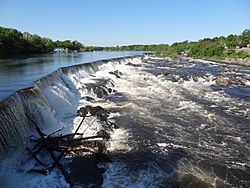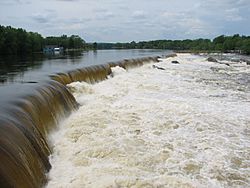Pawtucket Falls (Massachusetts) facts for kids
Pawtucket Falls are powerful waterfalls on the Merrimack River in Lowell, Massachusetts. The water here, including the rapids, drops about 32 feet over a distance of less than a mile. For many years before European settlers arrived, this spot was a very important fishing area for the Pennacook Native American people.
Contents
What Does Pawtucket Mean?
The name Pawtucket comes from the Algonquian language. It means "at the falls in the river." This name perfectly describes the location and its most famous feature.
A Natural Boundary Marker
For a long time, Pawtucket Falls helped mark the northern border of Massachusetts. This border was often argued over by the leaders of the Province of Massachusetts Bay and the Province of New Hampshire.
Finally, in 1740, a decision was made. The border would follow a curved line three miles from the Merrimack River. This line started near the ocean and went up to a spot three miles north of Pawtucket Falls. From there, the border would go straight west.
Canals and Dams: Powering a City
The Pawtucket Falls were a natural barrier for boats traveling along the Merrimack River. Because of this, the Pawtucket Canal was built in the late 1700s. This canal allowed boats to get around the falls.
Lowell: America's First Factory Town
In the 1820s, the falls, the canal, and the hydropower (water power) they offered made this spot perfect for a new town. Lowell became America's first planned factory town. For the next 30 years, the water power from Pawtucket Falls ran all of Lowell's many textile factories. This power was sent through the city's large canal system.
Building the Pawtucket Dam
To get the most power from the water, a large dam was started at the top of the falls in the 1820s. It was made even bigger in the 1840s.
The dam you see today is made of stone. It has wooden boards on top that are about five feet tall. For much of the year, this dam can send almost all the Merrimack River's water into the canal system. This means the Pawtucket Falls can sometimes look dry! When there is a lot of water, it flows over the dam. This creates a waterfall, which is what people call Pawtucket Falls today. However, this waterfall is only a small part of the total 32-foot drop.




